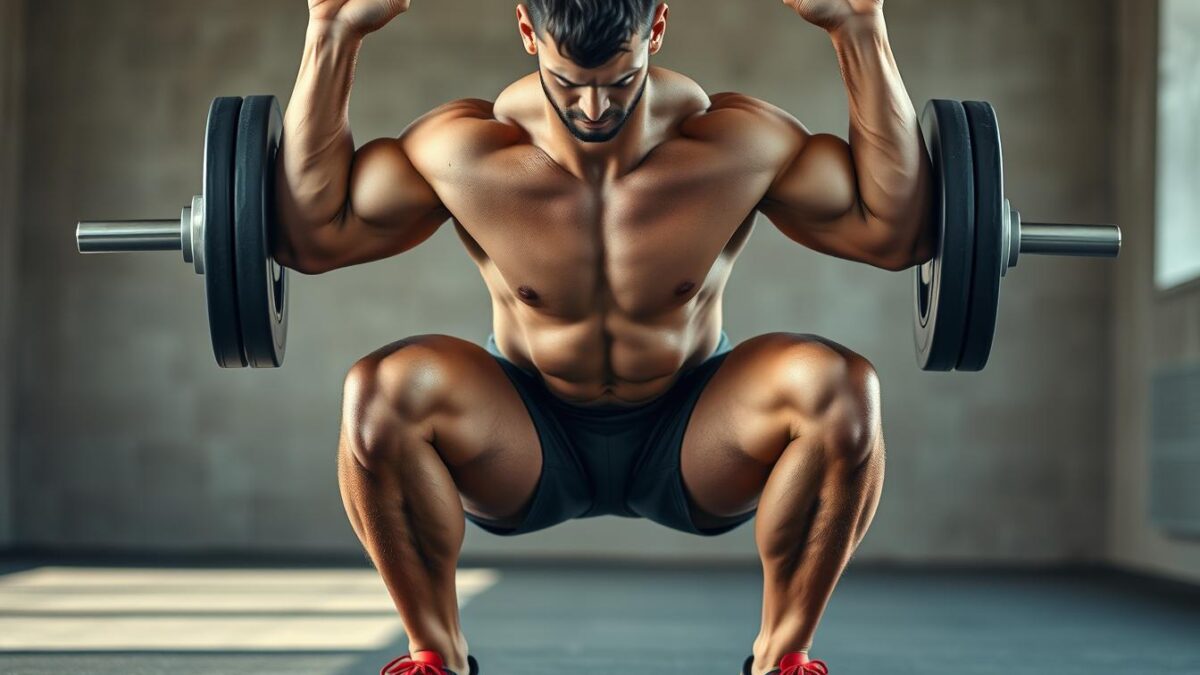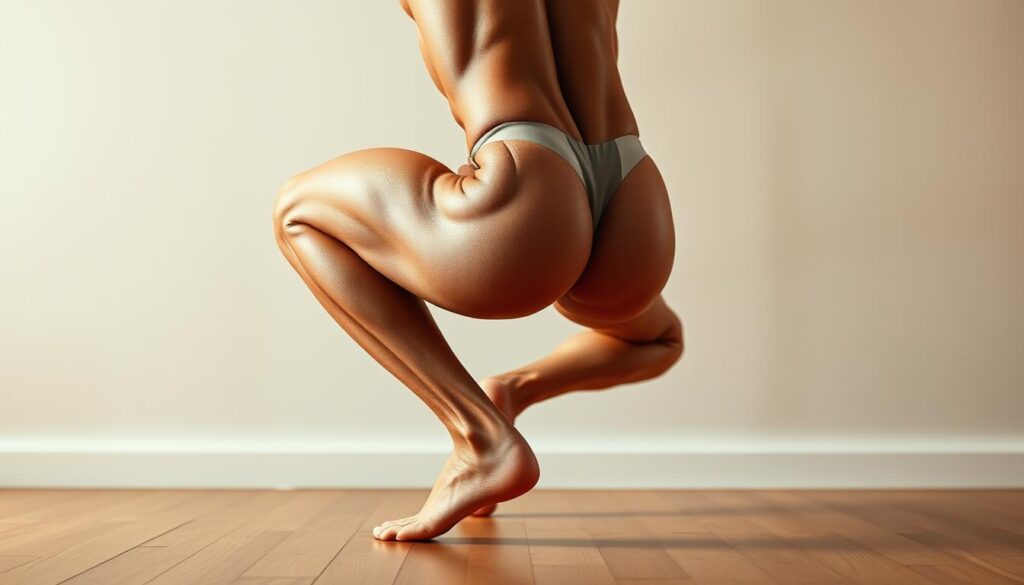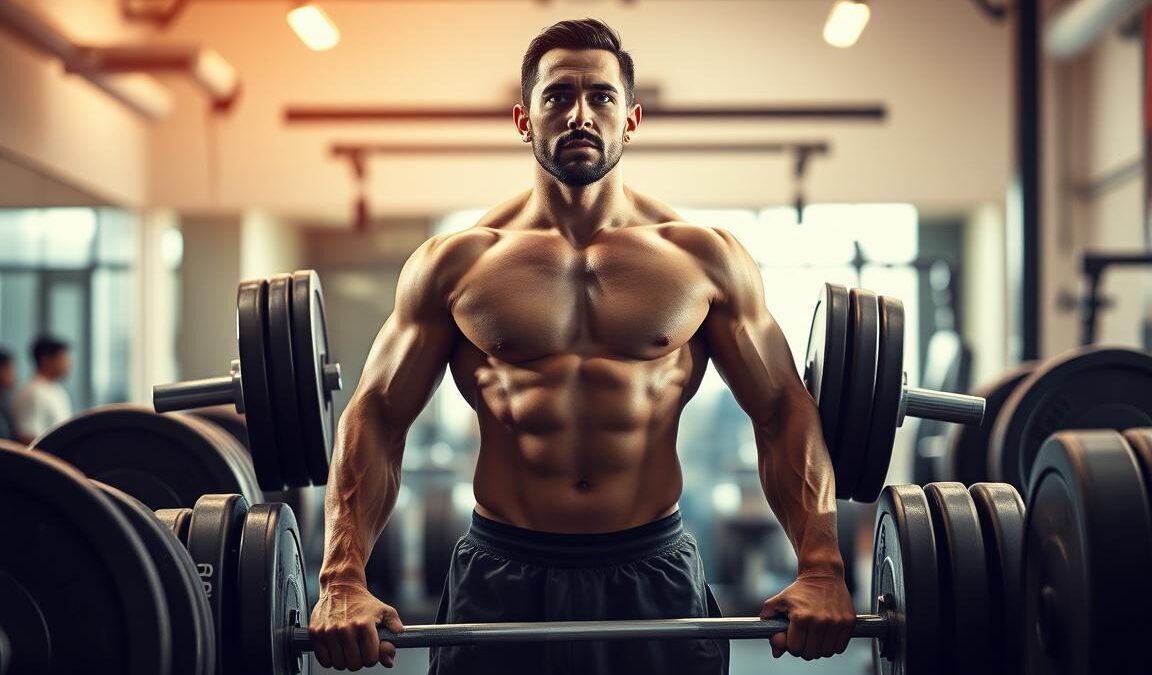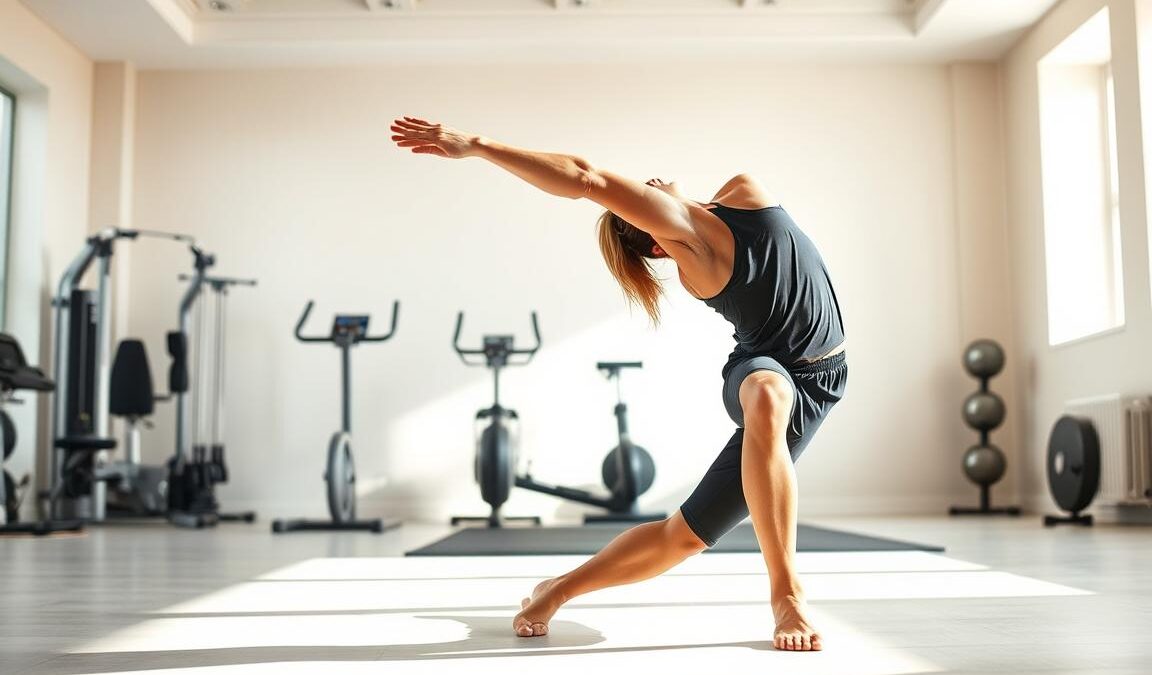
Find Your Perfect Squat Depth for Safety & Results
Ever thought about finding the right squat depth? Knowing how to optimize squat depth is key for reaching your fitness goals safely. We’ll explore safe squatting methods that boost your workout’s effectiveness and teach you the basics of proper squat form.
Learning effective squat techniques can take your fitness to the next level. It helps you build a strong, lasting strength training routine. Let’s begin your path to safer, more effective squats!
The Importance of Squat Depth in Your Workouts
Understanding squat importance is key for better workouts. The depth you squat affects muscle use, like in glutes, hamstrings, and quads. Reaching the right depth means more muscle fibers are used, boosting strength and stability.
While focusing on squat depth, don’t forget other important form aspects. Keep your back straight and knees over toes. This balance is vital for safe and effective workouts.
Using proper squat techniques leads to better muscle engagement and growth. By balancing depth and posture, you get the most out of your exercises.
What is Considered Good Squat Depth?
Good squat depth is key for a better workout and safety. It means lowering your thighs below parallel. This ensures your hip crease is below your knee joint. This depth is standard in powerlifting and fitness routines.
It’s important to note that not everyone needs to reach this depth. Your body’s shape and flexibility play a big role. So, while the standard depth is a good guide, listen to your body and fitness goals.
Understanding Joint Movement in Squats
The squat is a complex movement involving the hip, knee, and ankle joints. Each joint plays a key role in how well you can squat. The depth you can reach often depends on how flexible these joints are.
If your ankles are stiff, you might struggle to squat fully. This can lead to poor form and even injuries.
It’s important to understand how your joints move during squats. Recognizing these movements helps you spot areas that need work. You can then adjust your training to improve these areas.
Exercises and drills can help increase flexibility. This ensures your squats are safer and more effective.
By focusing on squat biomechanics, you can improve your performance and avoid injuries. Understanding how your joints move helps you tailor your squat depth. This way, you can get the most out of your workouts.
Identifying Your Unique Squat Depth
Knowing your squat depth is key for good training and avoiding injuries. Everyone’s squat depth is different, based on their goals, flexibility, and strength. If you’re into strength training, going deeper can work your muscles more.
But, if you want to improve your flexibility, a shallower squat is better. It helps you keep good form and boosts your flexibility.
To find your squat depth, look at how your body moves. Notice how your joints work during the squat. Try different squat styles to see what feels right and challenging for you.
Think about your hip, knee, and ankle flexibility. Personalized squatting helps you improve in a way that fits your fitness goals.
Finding your squat depth is about safety and challenge. Choose what feels good for your body. This way, you can get better without risking injury.
Squat Depth Optimization: Factors to Consider
Optimizing squat depth means knowing what affects it. Your goals are key in deciding how low to go. Athletes might aim for different depths than those focusing on muscle gain or injury prevention.
How flexible you are also matters. Tight hips or limited ankle mobility can stop you from squatting as low. Knowing these limits helps tailor your squatting plan.
Strength in key muscles like quads, hamstrings, and glutes is also important. Having strong muscles lets you squat deeper safely. Slowly increasing depth while keeping form right is key to avoid injuries.
Understanding these factors helps you make a plan that works for you. Here’s a table with important elements for optimizing squat depth:
| Factor | Description | Impact on Squat Depth |
|---|---|---|
| Individual Goals | Specific objectives such as muscle gain or athletic performance. | Determines the ideal squat depth for your training. |
| Flexibility | Range of motion in hips and ankles. | Directly influences depth capability and safety. |
| Muscle Strength | Strength in quads, hamstrings, and glutes. | Allows for deeper squats with more control. |
| Injury History | Past injuries affecting joints or muscles. | May restrict squat depth to prevent re-injury. |
| Mobility Restrictions | Any physical limitations in movement. | Can significantly affect depth capability. |
By understanding these factors, you lay the groundwork for better squatting. It ensures your workouts are safe and effective.
The Role of Mobility in Squat Depth
Getting to the bottom of a squat depends a lot on your mobility. If your mobility is limited, you might not be able to squat as deep as you want. Knowing what’s holding you back can help you improve and reach your squat goals.
Common Mobility Restrictions Affecting Squats
There are a few main areas where tightness can stop you from squatting well. Here’s what you need to watch out for:
- Ankles: If your ankles are stiff, you can’t lower your hips as much.
- Hips: Tight hip muscles or glutes can limit how far you can squat.
- Thoracic Spine: Not being able to move your upper back well can mess up your squat posture.
Techniques to Improve Mobility
Adding certain exercises to your routine can help you squat deeper. Here are some good ones:
- Dynamic Stretching: Do movements that feel like squats to get your joints ready.
- Wall Ankle Mobilizations: This stretch makes your ankles more flexible, helping you squat deeper.
- Hip Openers: Try stretches like pigeon pose or 90/90 hip stretch to loosen up your hips.
By focusing on these exercises, you can work on your stiffness and aim for that perfect squat depth.

Different Squat Depths for Different Goals
Your fitness goals help decide how deep you should squat. Knowing the difference between shallow and deep squats is key. It helps you get the most out of your workouts by matching squat depth to your goals.
Shallow Squats for Athletic Performance
Shallow squats are great for athletes wanting to boost their explosiveness. They mimic the movements needed for sports like jumping and sprinting. Training with shallow squats targets fast-twitch muscles, improving speed and agility.
Deep Squats for Muscle Gain
Deep squats are best for bodybuilders looking to grow their muscles. They work more muscle fibers, leading to bigger muscles. Using deep squat techniques helps build strength and muscle.
| Squat Type | Ideal For | Benefits |
|---|---|---|
| Shallow Squats | Athletes | Improved explosiveness, enhanced agility, and speed |
| Deep Squats | Bodybuilders | Increased muscle hypertrophy, overall strength, and muscle development |
Techniques to Achieve Optimal Squat Depth
To reach the best squat depth, start with your stance. A proper width helps with balance and alignment. Your feet should be a bit wider than shoulder-width apart.
This stance helps your knees track over your toes. It’s key for keeping good squat form.
Mobility is also important. Do dynamic warm-ups to loosen your hips and ankles. Leg swings and hip circles are great for this.
Practice squats with a target, like a box or bench. Lower the target as you get better. This helps you improve your squat depth.
Try different squat variations to build muscle memory. Front squats or goblet squats work different muscles. They help you master proper squat techniques.
Consistency is key. These practices strengthen your muscles and help you squat deeper. Always prioritize safety.
Use a mirror or record your squats. Seeing yourself helps refine your technique. It ensures you squat safely and effectively.
Common Mistakes to Avoid While Squatting
Learning the right squatting form is key to better workouts and fewer injuries. Many mistakes can mess up your efforts. One big mistake is letting your knees cave in during the squat. This not only makes you less stable but also raises the risk of getting hurt.
Another common error is rounding your back. Keeping your spine straight is important for safety and getting the most out of your workout. A curved back puts too much stress on your lower back, leading to pain and long-term problems.
Not keeping your heels on the ground while squatting can also hold you back. Lifting your heels messes up your balance and stops you from squatting as deep as you should. Being mindful of these mistakes helps make sure each squat is helping you get stronger and more conditioned.
Supporting Muscles and Proper Alignment
Mastering the squat is more than just bending your knees. It’s about using the right muscles. The glutes, quadriceps, and hamstrings are key. They work together to keep your body aligned, making squats safe and effective.
When squatting, keep your spine straight and your core tight. This alignment spreads your weight evenly, lowering injury risk. Weak muscles can cause misalignments, leading to strain. So, strengthen your core and the muscles around it for better squats.
Doing exercises that target these muscles can boost your squat depth and technique. Pay attention to your body’s signals during squats. Adjusting as you go will help build a strong and lasting squat routine.
| Muscle Group | Primary Function | Importance in Squats |
|---|---|---|
| Glutes | Hip extension and stability | Creates power for lifting and stabilizes the pelvis |
| Quadriceps | Knee extension | Essential for rising from the squat position |
| Hamstrings | Knee flexion and hip extension | Supports joint stability and assists in lowering and raising |
| Core Muscles | Spinal stabilization | Maintains proper posture and alignment |
Enhancing Your Squat with Accessory Exercises
Adding squat accessory exercises to your routine can really help you improve. These exercises help you practice going deeper and maintaining the right form. Goblet squats and box squats are great because they focus on proper technique and depth.
Effective Exercises for Improving Depth
Here are a few effective exercises to add to your routine:
- Goblet Squats
- Box Squats
- Bulgarian Split Squats
- Hip Thrusts
These exercises target different parts of your squat. They help build stability and strength at various depths. Regularly doing these exercises will improve your squat depth and skill.
The Importance of Corrective Exercises
Working on specific weaknesses can greatly improve your squat. Corrective exercises for squats focus on areas that need work, like mobility or muscle balance. Single-leg deadlifts and lunges are great for targeting these weaknesses.
These exercises not only boost your squat power but also lower injury risk. As you train, adding these exercises will help you achieve better squat results.
| Exercise | Target Area | Benefits |
|---|---|---|
| Goblet Squats | Quads, Core | Improves squat depth and form |
| Box Squats | Glutes, Hamstrings | Enhances explosive power off the box |
| Bulgarian Split Squats | Legs, Balance | Increases single-leg strength |
| Single-Leg Deadlifts | Hamstrings, Core | Corrects muscle imbalances |
Busting Myths About Squat Depth
In the world of fitness, many myths about squat depth confuse beginners. Some think the only good squat is “ass-to-grass.” But, not everyone needs or can do deep squats. Your body and goals decide the best squat depth for you.
Clearing up squat depth myths can ease the worry of trying to meet high standards. Misunderstandings about squatting might stop people from trying. Instead, focus on doing squats right and in control. Knowing your squat depth is right for you boosts your confidence in workouts.
The fitness journey is unique for everyone. What’s good for one might not be for another. Accepting your squat depth, whether it’s shallow or deep, based on what feels right, helps you progress better. Let’s drop the pressure of false beliefs and find a squat routine that fits you.



